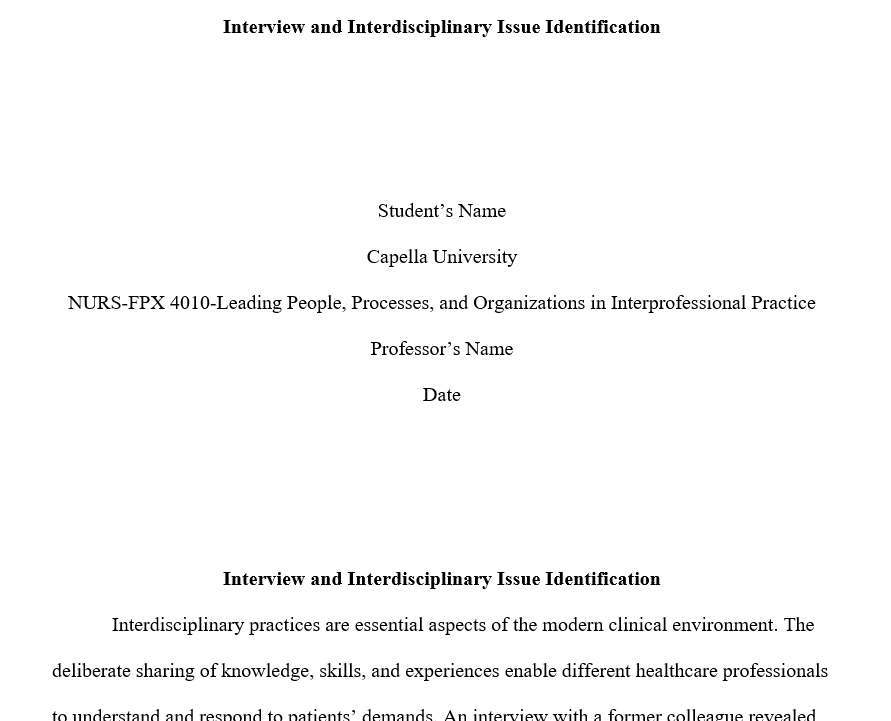NURS-FPX4010_N_Assessment 2-1 Solution.docx
Interview and Interdisciplinary Issue Identification
Student’s Name
Capella University
NURS-FPX 4010-Leading People, Processes, and Organizations in Interprofessional Practice
Professor’s Name
Date
Interview and Interdisciplinary Issue Identification
Interdisciplinary practices are essential aspects of the modern clinical environment. The deliberate sharing of knowledge, skills, and experiences enable different healthcare professionals to understand and respond to patients’ demands. An interview with a former colleague revealed the need for nurses and other professionals to embrace collaboration to enable them optimize health outcomes. The colleague works as a nurse manager in a leading not-for-profit healthcare facility.
The position makes her familiar with complexities in the care environment and the role of interdisciplinary collaboration in enhancing quality and safety of patient care. I developed a semi-structured questionnaire, which enabled me to ask questions on several topics such as leadership, technology, and challenges that require collective efforts to identify lasting solutions.
Some of the issues revealed by the interviewee include a rising number of patients with chronic conditions, high population of elderly clients, and calls for the involvement of patients and families in decision-making. The interviewee also highlighted the demand for patient-centered practices that enhance access to care and strengthen the quality and safety of services.
Technology is another primary consideration due to calls for streamlined workflows, data-driven decisions, and remote collaboration among patients and different healthcare professionals. Working as a nurse manager provides opportunities to engage members of the care team, understand challenges, and areas for improvements across the care continuum.
Issue
The nurse manager indicated that the growing population of elderly patients with chronic conditions is among the primary concerns for the organization. The group requires maximum attention to enable healthcare professionals handle complex demands. In this case, there are risks of burnout, workload, and medication errors caused by complexities in the clinical environment (Gupta et al., 2017).
The patients require high-risk medications and other sophisticated procedures that could trigger errors. The errors cause prolonged hospitalization, readmissions, and additional costs for patients and the organization. Interdisciplinary collaboration creates opportunities for nurses, physicians, pharmacists, and other groups to share insights into the causes of medication errors and sustainable solutions.
Change Theories
The Plan-Do-Study-Act (PDSA) model guides health leaders to collaborate with the workforce to develop and implement a pathway for addressing medication administration errors. The framework allows the team to break down tasks into steps, evaluate outcomes, and improve processes to achieve the intended results (McNicholas et al., 2019). Ideally, each PDSA contains a single step of the implementation, which makes the process brief and manageable. With the PDSA framework, the team understands the plan and adjustments necessary to achieve the best results.
Leadership Strategies
Successful change processes depend on leaders’ ability to initiate and maintain interdisciplinary collaboration. Nurses, physicians, nurse manager, clinical assistants, pharmacists, and a nurse educator share unique perspectives on medication errors, causes, and evidence-based solutions. The goal is to respond on time to issues that jeopardize the organization’s credibility, profitability, and ability to maximize patient satisfaction.
. The leader sets the direction and inspires individuals and teams to dedicate time and energy to achieving the intended results. The transformational leadership is crucial to establish a multidisciplinary team and encourage everyone to have a role in the change success (Khalil & Lee, 2018). For successful outcomes, the leader clarifies the purpose, clarifies the benefits of the process, and engages team members to create a culture that values change. A bottom up approach is also vital to maintain support and remove barriers.
Interdisciplinary Collaboration
The interdisciplinary team has nurses, physicians, nurse manager, pharmacists, and radiologists responsible for promoting safe medication administration. The members have frontline roles that make them open to new ideas, collaboration, and cooperation (Manias, 2018). Interdisciplinary collaboration also entails valuing everyone’s contribution and accepting ownership in the success or failure of the team. Thus, members deliberately share knowledge, ideas, and experiences on evidence-based and sustainable solutions for medication administration errors.
References
Gupta, D., Boland, R., & Aron, D. (2017). The physician’s experience of changing clinical practice: A struggle to unlearn. Implementation Science, 12(28), 1-10. https://implementationscience.biomedcentral.com/articles/10.1186/s13012-017-0555-2
Khalil, H & Lee, S. (2018). The implementation of a successful medication safety program in a primary care. Journal of Evaluation in Clinical Practice, 24(5), 1-5. https://onlinelibrary.wiley.com/doi/abs/10.1111/jep.12870
Manias, E. (2018). Effects of interdisciplinary collaboration in hospitals on medication errors: An integrative review. Expert Opinion on Drug Safety, 17(3), 259-275. https://pubmed.ncbi.nlm.nih.gov/29303376/
McNicholas, C., Lennox, L., Woodcock, T., Bell, D., & Reed, J. E. (2019). Evolving quality improvement support strategies to improve plan–do–study–act cycle fidelity: A retrospective mixed-methods study. BMJ Quality & Safety, 28(5), 356–365. https://pubmed.ncbi.nlm.nih.gov/30886118/



